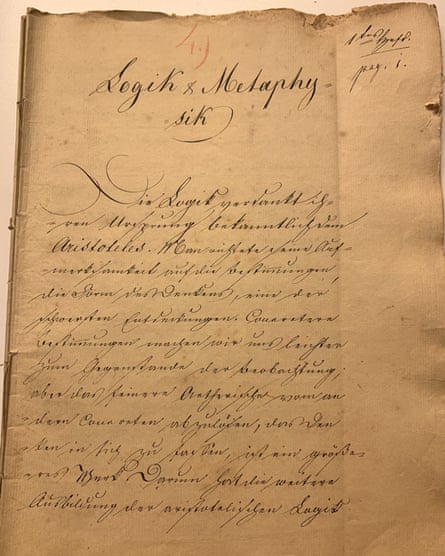“Hegel first lectured on aesthetics in Heidelberg. By the time he was lecturing in Berlin, he had reworked his ideas significantly,” said Illies. “This is the first time any transcript of these original lectures from Heidelberg has been found.”
It may be too early to say whether any completely new and unknown ideas from Hegel are hidden within the papers, but the research project expects that understanding of the philosopher, as well as that of his students, will be deepened. 
Vieweg’s find is probably the single largest of its kind ever made. It was unearthed after a reader of his recent biography on Hegel pointed him to the archive of Friedrich Windischmann. Windischmann was a professor of Catholic theology in Munich whose father, Karl Joseph Hieronymous Windischmann, was a philosopher and friend of Hegel. A letter between Hegel and Karl Windischmann shows that Carové gave the set of manuscripts to the latter as a gift.
A biographer researching the German philosopher Hegel has uncovered a massive treasure trove of previously undocumented lectures that could change perceptions regarding one of the leading figures of modern western philosophy.
It has also emerged that the topic of freedom – the theme for which Hegel is perhaps best known – is also touched upon in the transcript.
An initial look through the pages pertaining to aesthetics has revealed a number of interesting details that illustrate Hegel’s thought processes. His early views on the definition of art, for example, come through clearly.
Hegel’s ideas and works are notable for their formidable difficulty. The British philosopher Bertrand Russell described him as “the hardest to understand of the great philosophers”. Vieweg hopes the new find might bring clarity.
“Not only do the first pages deal with this central subject of freedom, but the last pages also look at it. The transcript ends with an emphasis on the self, on individual freedom and its portrayal within art. It shows us that art undoubtedly contributes to an idea that is so critical to our lives today, that education leads to freedom,” said Vieweg.
He said an early reading of the notes had hinted at a fresh understanding of how Hegel formed his influential ideas on aesthetics, the philosophy around beauty and art, and how he analysed Shakespeare’s plays to help develop his ideas.
Hegel’s ideas on the difference between art and religion seem to be defined more clearly in the transcripts and he appears to discuss a wide array of themes, ranging from Aristotle’s text on poetics, Sophocles’ Antigone and Aristophanes’ comedy to Shakespeare’s Hamlet, Goethe, and Friedrich Schiller’s drama The Robbers. Finally, for the first time, Hegel defines the three paradigms of philosophical art history as symbolic, classical and romantic, and also highlights the importance of Shakespeare’s drama.
More than 4,000 pages of notes on Georg Wilhelm Friedrich Hegel’s lectures were found by Klaus Vieweg in the library of the archdiocese of Munich and Freising.
Although research on the material has only just begun, there has already been one significant find: the boxes contain a transcript from one of the very first lectures Hegel gave on aesthetics.
“Major sections of Hegel’s work are only known through his lectures, so scholars have long been trying to find transcripts,” said Illies. “Several were found and published in the 19th and 20th centuries, but over the years uncovering new material has become less and less likely.”
“Carové was a very intelligent, careful, student who followed Hegel for several years. We can therefore hope for previously unknown theses, remarks and assumptions from Carové’s interpretation of these lectures, as well as for a better understanding of the development of Hegel’s thought,” said Illies. “And there might be more to come. We are looking forward to being surprised.”
Currently, any knowledge of Hegel’s thoughts on aesthetics originates from much later lectures given in Berlin. These were published after his death by his student Heinrich Gustav Hotho using a combination of lecture transcripts and Hegel’s own notes. As there have been no other sources to compare this with, questions have arisen as to how far this material was influenced by Hotho. The discovery of early lectures, therefore, could help to finally clear up the uncertainty.
“The text shows Hegel defining art as this beautiful middle ground between thought and reality. He suggests that the proper function of art is the harmony of abstraction and reality,” said Vieweg. “We’re seeing the very foundation of his later theories. At this stage it is a work in progress.”
“The discovery of these manuscripts is comparable to finding a new score by Beethoven or a previously unseen painting by Constable,” said Vieweg, a professor at the Friedrich Schiller University Jena in Germany.

